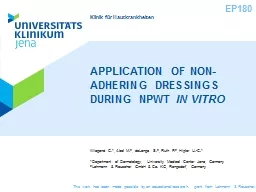

in vitro Klinik für Hautkrankheiten Wiegand C 1 Abel M 2 deLange S 2 Ruth P 2 Hipler UC 1 1 Department of Dermatology University Medical Center Jena Germany ID: 933076
Download Presentation The PPT/PDF document "application of non-adhering dressings du..." is the property of its rightful owner. Permission is granted to download and print the materials on this web site for personal, non-commercial use only, and to display it on your personal computer provided you do not modify the materials and that you retain all copyright notices contained in the materials. By downloading content from our website, you accept the terms of this agreement.
Slide1
application of non-adhering dressings during NPWT in vitro
Klinik für Hautkrankheiten
Wiegand C.1, Abel M.2, deLange S.2, Ruth P.2, Hipler U.-C.1 1Department of Dermatology, University Medical Center Jena, Germany2Lohmann & Rauscher GmbH & Co. KG, Rengsdorf, Germany
This work has been made possible by an educational/research grant from Lohmann & Rauscher.
EP180
Slide2Introduction
Negative pressure wound therapy (NPWT) has been shown to be clinically effective in the treatment of chronic-stagnating wounds. However, the exact mechanism of action on wound healing still remains to be elucidated. It is thought that the decrease of the local and interstitial tissue edema, increased perfusion of the (peri-)wound area, reduction of bacteria, and mechanical stimulation of the wound bed account for the beneficial effects [1,2]. In vitro studies suggest that positive effects of NPWT result from the recruitment of cells to the wound site. It could be shown that the dressings used for NPWT exhibit different effects, cells especially show a significant tendency to grow into large-pored
foams [3]. We have used an in-vitro-model for NPWT to investigate the effects of the combination of the non-adhering dressings LP, DT, and MP with a large-pored PU foam dressing on fibroblasts.2
Figure 1:
Schematic set-up (A) and photograph (B) of the assembly with the 3D-fibroblast cultures covered with the dressings and placed in the 6-well-plate with a VAL.
EP180
Material & Methods
The
non-adhering dressing samples LP, DT, and MP were placed together with the PU foam dressing on fibroblast 3D-cultures. The assembly was positioned in a 6-well-plate and sealed with a vacuum-applicator-lid (VAL). VALs were connected to medium supply and vacuum pump. Experiments were carried out at -80mmHg for 48h (figure 1). Histology specimens were stained with haematoxylin/eosin and fibroblasts were detected using anti-vimentin-antibodies. Cell viability and ingrowths of cells into samples was determined.
LP -
Lomatuell®Pro, Lohmann&Rauscher; DT – Duratouch◊, Smith & Nephew; MP - Mepitel®, Mölnlycke Health Care; PU foam - CNP®foam, Lohmann&Rauscher
[1] Moues et
al.
Wound Rep
Reg
2008; 16:488-494
[2]
Borgquist
et
al. Wounds
2009;
21:302-309
[3] Wiegand et al. Wound Rep
Reg
2013; 21:697-703
Slide3Results
Combination of the non-adhering dressings with the PU foam did not affect cells
negatively (figure 2) and fibroblasts responded to subatmospheric pressure by migrating in direction of the applied vacuum (figure 3). No distinct differences were observed in the application of LP, DT or MP during NPWT at -80 mmHg in vitro. In addition, no adverse effects on the structure of the non-adhering dressings were observed at microscopic level (figure 4).
3
Figure
2:
NPWT
at
-80 mmHg
with all dressing combinations decreased the number of fibroblasts in 3D-cultures
compared to incubator and a static control indicating a loss of cells by migration beyond the pellicle edge.
EP180
Slide44
Figure 3:
Fibroblasts in the 3D-cultures responded to NPWT by migrating in the direction of the applied vacuum
independently from the non-adhering dressing used.
EP180
w/o
dressing
LP + CNP
foam
dressing
MP + CNP
foam dressingDT + CNP
foam dressing
Slide5Conclusion
It could be shown that the combination of non-adhering dressings and PU foam demonstrates good cell compatibility and does not negatively affect cell viability. Moreover, combination of all non-adhering dressing and PU foam dressing samples allowed induction of fibroblast migration in direction of the applied vacuum during NPWT at -80 mmHg.
5
Figure 4:
No
adverse effects on the structure of the non-adhering dressings were observed at microscopic
level after NPWT at -80 mmHg compared to the untreated control.
EP180
untreated
NPWT
treatment
untreated
NPWT
treatment